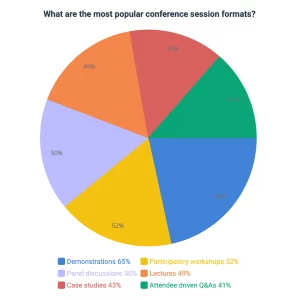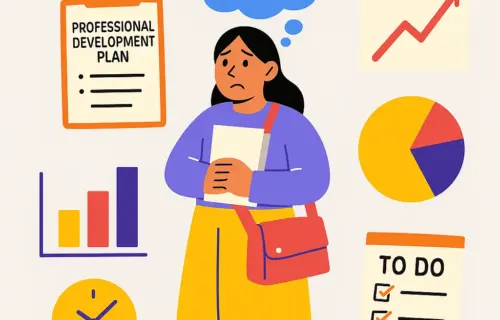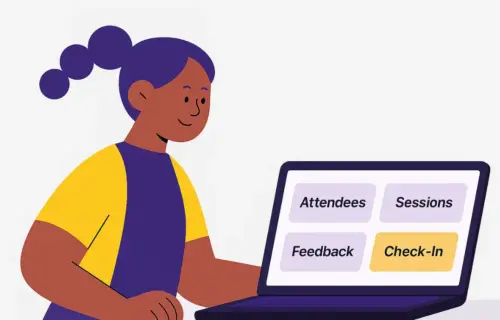Attention conference planners in the world of K-12 education: prepare to dodge those pesky planning potholes!
In this article, we’ll unveil the secrets to organizing flawless professional development conferences. Get ready to avoid the common pitfalls and host A+ events!
The Importance of K-12 Professional Development Conferences
Table of contents
- 1 The Importance of K-12 Professional Development Conferences
- 2 Not Defining Your Professional Development Conference Objectives
- 3 Failing to Identify Your Target Audience
- 4 Choosing the Wrong Professional Development Conference Format
- 5 Selecting Irrelevant Session Topics
- 6 Stuffing Your Conference Schedule
- 7 Inviting the Wrong Speakers
- 8 Ineffectively Tracking Attendance
- 9 Wasting Time & Resources
- 10 Not Building an Inclusive Environment
- 11 Skipping Event Evaluation and Feedback
- 12 No Post-Conference Follow-Up
- 13 Conclusion
K-12 professional development conferences play a crucial role in advancing the knowledge and skills of educators.
One of the key benefits of K-12 professional development conferences is the opportunity to learn new teaching methods. These conferences often feature workshops and sessions led by experts in the field who share innovative strategies and techniques that can be implemented in the classroom.
Educators can gain valuable insights into effective instructional practices, assessment methods, and classroom management strategies. By incorporating these new approaches into their teaching, educators can engage students more effectively, promote critical thinking, and foster a positive learning environment.
In addition to learning new teaching methods, K-12 professional development conferences provide educators with access to the latest research and trends in education. The field of education is constantly evolving, with new research studies and best practices emerging regularly.
Attending conferences allows educators to stay up to date with these advancements and incorporate evidence-based strategies into their teaching. This enables educators to deliver high-quality instruction that is aligned with current educational standards and best practices.
Furthermore, K-12 professional development conferences offer opportunities for networking and collaboration with other professionals in the field. These conferences provide a platform for educators to connect with colleagues from different schools or districts, exchange ideas, and share experiences. Collaborating with other professionals can inspire new approaches to teaching, promote interdisciplinary learning, and create a support network for educators.
Not Defining Your Professional Development Conference Objectives
You wouldn’t go somewhere you’ve never been without opening your Maps App. So why would you build a conference without objectives? Your objectives are where you need to go, and they determine the steps along your route.
- 80% of attendees believe that the most crucial factor for a successful event is whether it met their objectives and expectations.
Failing to define clear goals for your professional development conference can lead to a lack of focus and purpose. This section emphasizes the importance of setting measurable goals and aligning them with the needs of the attendees.
- Lack of Focus: Without clear objectives, the conference may lack focus and direction. Participants may be unsure about the purpose of the event, leading to a disengaged audience and reduced overall impact.
- Ineffective Planning: Objectives serve as a foundation for planning and organizing the conference. Without them, it becomes challenging to structure the agenda, select appropriate speakers, and design relevant sessions.
- Misaligned Content: The lack of defined objectives can result in content that doesn’t align with the audience’s needs and expectations. Attendees might leave feeling dissatisfied, as the conference fails to address their interests and concerns.
- Evaluation Difficulties: Objectives provide a benchmark for evaluating the success of a conference. Without clear objectives, it becomes difficult to assess whether the event met its intended goals or made a meaningful impact.
- Wasted Resources: Organizing a conference requires significant time, money, and effort. Without objectives, there’s a risk of misallocating resources to irrelevant activities or unnecessary amenities that don’t contribute to the conference’s purpose.
- Missed Opportunities: By not defining objectives, you may miss out on potential partnerships, sponsorships, or collaborations that could have supported your event’s goals.
- Confusion for Speakers and Presenters: Speakers and presenters might struggle to tailor their content appropriately without a clear understanding of the conference’s objectives. This could lead to presentations that are either too broad or too specialized for the audience.
- Difficulties in Promoting the Conference: Marketing and promoting the event become challenging without well-defined objectives. Potential attendees may not see the value of participating if the purpose of the conference is unclear.
- Reduced Attendee Engagement: When attendees are uncertain about the conference’s purpose, they may be less motivated to actively participate in discussions, workshops, and networking opportunities.
- Reputation Impact: A conference without clear objectives could receive negative feedback from attendees and stakeholders, affecting its reputation and making it harder to attract participants in the future.
Failing to Identify Your Target Audience
When it comes to planning top-notch professional development experiences for K-12 educators, understanding their needs and preferences is like having a secret superpower. You’ve got the chance to design tailor-made events that leave them buzzing with inspiration and newfound knowledge. So, let’s dive into the playbook of strategies that’ll help you hit the bullseye with your educator audience!
First up, let’s talk stats! Did you know that 94% of educators believe that personalized professional development has a significant impact on their teaching practices? So when you cater to their specific needs, you’re not only making their lives easier but also empowering them to be the best they can be in the classroom.
How do we identify them? One way to do this is by conducting surveys or focus groups to gather direct feedback from educators. Ask them what topics they want to learn more about, what challenges they face, and how they prefer to engage in professional development.
Up next, let’s talk immersion. The data that shows 83% of educators prefer hands-on learning experiences like workshops and interactive sessions. So, consider incorporating immersive activities, demonstrations, and networking opportunities into your events. This will keep them engaged and energized throughout the whole experience.
Remember, it’s all about creating that connection with your educator audience. Tap into their passions, interests, and teaching styles. Offer a mix of content that addresses different grade levels, subjects, and teaching methodologies. The more relevant the content, the more they’ll feel that your event was custom-made just for them.
Choosing the Wrong Professional Development Conference Format
We know how crucial it is to get the format just right. So, let’s dive into the secret sauce of conference formats that’ll have everyone singing your praises!
Here’s a startling stat for you: traditional lecture-style sessions result in a knowledge retention rate of just 5%. However, when attendees get their hands dirty and engage in interactive workshops or experiential activities, the retention rate skyrockets to a whopping 75%.
Further still, 87% of conference attendees prefer interactive sessions where they can actively participate and engage with speakers and fellow attendees. It’s like creating a vibrant dance floor where ideas are exchanged, connections are made, and inspiration flows freely.
Remember, variety is the spice of life! Just like a dynamic playlist keeps people grooving, a diverse range of conference formats keeps attendees captivated. Mix it up with a blend of keynote speeches, breakout sessions, workshops, and networking activities. This way, you’ll cater to different learning styles and keep everyone fully engaged.
Selecting Irrelevant Session Topics
Crafting session content that is relevant to the current challenges and trends in K-12 education is the secret to keeping your attendees hooked and coming back for more. So, let’s help you choose topics that will have educators nodding in agreement and thirsting for more knowledge.
Did you know that 79% of educators believe that relevant and timely professional development has a significant impact on student learning outcomes? That’s right! When you hit the bullseye with your topics, you’re not just empowering educators; you’re also positively influencing their students’ educational journey.
You can do this by conducting surveys or polls to gather insights directly from educators. Ask them about the challenges they face in the classroom, the latest trends they’re curious about, and the skills they want to develop. This way, you’ll have a treasure map that leads you straight to the most sought-after topics.
Now, picture this: educators discussing innovative ways to implement project-based learning to enhance student engagement; tackling the latest approaches to blended learning in the digital age; or exploring strategies to create inclusive and equitable classrooms. These are the kind of topics that will make your event a must-attend for every educator hungry for growth and impact.
Don’t forget to stay ahead of the curve! Keep your finger on the pulse of education trends and emerging challenges. Explore themes like social-emotional learning, personalized learning, or technology integration. Being at the forefront of these discussions will make your event a hub of inspiration and thought leadership. Here are some trending topics to get you started:
- Technology Integration: The use of technology in K-12 education has been on the rise, with schools incorporating various digital tools and platforms to enhance learning experiences. This includes the adoption of interactive whiteboards, educational apps, online learning management systems, and virtual classrooms.
- Personalized Learning: Educators have been increasingly exploring personalized learning approaches, tailoring teaching methods and content to individual students’ needs and learning styles. Adaptive learning platforms and data-driven insights help teachers personalize instruction and provide targeted support to students.
- Project-Based Learning (PBL): PBL has gained popularity as an effective teaching method, where students engage in real-world projects to deepen their understanding of concepts and develop problem-solving skills. It promotes active learning and student-centered classrooms.
- STEAM Education: Integrating Science, Technology, Engineering, Arts, and Mathematics (STEAM) into the curriculum has been emphasized to nurture students’ creativity, critical thinking, and problem-solving abilities. This approach aims to prepare students for future careers that require multidisciplinary skills.
- Gamification: Gamification elements have been used in educational settings to make learning more engaging and enjoyable. This involves incorporating game-like features, such as rewards, levels, and challenges, to motivate students and enhance their learning experiences.
- Social-Emotional Learning (SEL): K-12 schools have recognized the importance of addressing students’ social and emotional well-being. SEL programs focus on developing emotional intelligence, empathy, self-awareness, and interpersonal skills.
- Online and Blended Learning: The expansion of online and blended learning models has allowed students to access education beyond traditional classroom settings. This approach provides flexibility and personalized pacing, accommodating diverse learning needs.
- Data Analytics and Learning Analytics: Schools and educational institutions have been leveraging data analytics to track student progress, identify learning gaps, and make data-driven decisions to improve overall academic outcomes.
- Open Educational Resources (OER): The use of OER has increased, providing teachers and students with free or low-cost educational materials, including textbooks, videos, and interactive resources.
- Coding and Computer Science Education: Many K-12 schools have integrated coding and computer science education into their curriculum to equip students with essential digital literacy skills and prepare them for future careers in technology.
- Augmented Reality (AR) and Virtual Reality (VR): AR and VR technologies have been explored to create immersive and interactive learning experiences, allowing students to visualize complex concepts and explore virtual environments.
- Social Learning Platforms: Online platforms that facilitate social learning and collaboration among students have gained popularity, enabling them to work together on projects, share ideas, and engage in peer-to-peer learning.
Stuffing Your Conference Schedule
When you write a to-do list for tomorrow, you sometimes amaze yourself with how efficient you are. Or think about a travel itinerary cleanly mapped out and timetabled. You get caught up in the romance of the planning and the Tetris-like elements falling into place.
However, when it comes to getting that work done, it’s never that simple, is it? You need breaks to get good work done.
- 68% of attendees say that the quality and variety of sessions and speakers are important factors for their overall event experience.
In short, you need balance. Overloading the conference schedule with too many sessions can lead to information overload and fatigue. Balance content, breaks, and opportunities for engagement to ensure a well-paced and engaging conference experience.
Inviting the Wrong Speakers
Selecting speakers for a conference is a pivotal task. The impact of inviting speakers who lack expertise or fail to inspire attendees can be detrimental to your professional development conference’s success.
Data from previous conferences highlight the significance of choosing knowledgeable and motivating speakers. For instance, a study revealed that 80% of attendees listed speaker quality as a top influencer of their satisfaction with a conference.
This can be achieved through several effective strategies. Firstly, evaluating the professional achievements and credentials of potential speakers provides insights into their expertise and contribution to the education sector. Renowned educators and individuals who have spearheaded successful education initiatives are likely to be valuable assets as speakers.
Secondly, considering recognitions, awards, and honors received by prospective speakers further substantiates their expertise and inspirational capabilities. Research has shown that speakers who have been recognized for their outstanding contributions tend to have a lasting impact on the audience.
Moreover, quantifying audience engagement during previous speaking engagements is essential to gauge a speaker’s ability to inspire and motivate. Send attendees post-event surveys to gather valuable feedback for your next professional development conference.
Lastly, collecting testimonials and success stories from past conference attendees can offer valuable insights into the inspirational qualities of previous speakers. Personal anecdotes and impactful narratives leave a lasting impression on the audience, driving motivation and enthusiasm.
Ineffectively Tracking Attendance
Inefficient attendance tracking processes can lead to inaccuracies and difficulties in allocating professional development credits.
This section explores the importance of implementing easy and reliable check-in systems and outlines strategies for managing professional development credit allocations.
- Integrate attendance tracking with education event management software for seamless data management.
- Offer self-check-in kiosks or mobile apps to enhance attendee convenience.
- Conduct regular audits and data validation to ensure accuracy in credit allocations.
- Provide clear communication to attendees about the credit allocation process and criteria.
- Collect feedback from attendees to continually improve the attendance tracking and credit allocation process.
Wasting Time & Resources
You wouldn’t believe the time and resources that can go down the drain when event organizers fail to tap into the power of event management software! Let’s take a look at some eye-opening stats and examples that illustrate the benefits of using this tech-savvy tool for conference planning.
- Streamlining Conference Planning: Organizing a conference without event management software is like navigating through a labyrinth blindfolded. 75% of event planners reported that using event management software significantly reduced their planning time. With a centralized conference management platform, you can bid farewell to those chaos-filled days of spreadsheets and Google Forms.
- Simplify Registration Process: 67% of attendees prefer online event registration. Event management software offers easy-to-use registration forms, enabling attendees to sign up with just a few clicks. No more lengthy paper forms or endless back-and-forth emails; it’s all about creating a seamless and user-friendly experience.
- Efficient Communication: Communication can make or break any event. 80% of event planners agreed that event management software improved their communication with both attendees and stakeholders. From sending out mass emails and personalized updates to sending push notifications, you can keep everyone in the loop effortlessly.
- Data Management Made Easy: Event management software saves you from drowning in a sea of data chaos. 63% of event organizers noticed a significant improvement in data accuracy when using event management software for reporting and analytics. The software can help you track registrations, collect feedback, and analyze attendee engagement, providing valuable insights to make data-driven decisions.
Ready to discover more? Try it for free.
Not Building an Inclusive Environment
Neglecting to create an inclusive environment at conferences can negatively impact the learning experiences of attendees from different backgrounds and perspectives. Let’s explore some effective strategies to make everyone feel welcome and ensure their learning needs are met.
- Fostering an Inclusive Atmosphere: Inclusivity is the heart and soul of a successful conference. One way to achieve this is by featuring a diverse lineup of speakers and presenters who can represent various perspectives and experiences. According to a study by the Center for Exhibition Industry Research (CEIR), events with diverse speakers are more likely to attract a broader and more engaged audience. By embracing diversity on stage, you set the tone for an inclusive atmosphere where everyone feels valued and heard.
- Promoting Equity and Accessibility: Accessibility is not just a buzzword; it’s a fundamental aspect of organizing an inclusive conference. Make sure the event venue is accessible to people with disabilities, and provide necessary accommodations, such as sign language interpreters or captioning services for the deaf and hard of hearing. Additionally, offer materials in multiple formats, like large print, mobile, and web versions.
- Encouraging Open Dialogue: Creating a safe space for open dialogue is essential to embracing diversity and promoting understanding. Facilitate Q&A sessions, interactive discussions, and networking opportunities where attendees can share their perspectives and learn from one another. Encourage respectful and constructive conversations, ensuring that every voice is heard and respected.
Skipping Event Evaluation and Feedback
To improve your professional development events, you need to analyze your performance – and most importantly listen to people.
- Gathering attendee feedback allows event organizers to gain valuable insights into the attendees’ experience. 68% of event professionals consider attendee feedback to be essential for improving future events.
Neglecting to evaluate the impact of the conference by sending post-event surveys can prevent organizers from making improvements and meeting the needs of attendees. So stay on top of post-conference evaluations and collect feedback to enhance future conferences.
No Post-Conference Follow-Up
Lacking post-conference content can hinder the ongoing support and engagement of attendees. This section discusses the importance of providing post-conference resources, networking opportunities, and ongoing support to maximize the impact of the professional development experience.
- 75% of event professionals believe that post-event activities are essential for maintaining attendee satisfaction and fostering long-term engagement.
- A study by the Learning and Performance Institute found that learners typically forget 70% of what they learn within 24 hours without reinforcement.
Think of it like a game of basketball. The game might end after the buzzer, but after you’ve got celebrations, highlights, interviews, parties, articles, and so on. So when the buzzer goes on your conference, you set the post-match program in motion.
Conclusion
Avoiding common planning mistakes in K-12 professional development conferences is vital for creating impactful and engaging experiences for educators.
By addressing the key areas discussed in this guide, you can optimize the planning process and ensure that your conference meets the needs of attendees while driving growth and learning in K-12 education.
And, as a reward for your efforts in research, enjoy a free demo of our very own event planning software here at Sched.
Want to test it out for yourself? Get started with a free trial today.









